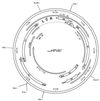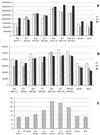Identification of six putative novel human papillomaviruses (HPV) and characterization of candidate HPV type 87
- PMID: 11689676
- PMCID: PMC114781
- DOI: 10.1128/JVI.75.23.11913-11919.2001
Identification of six putative novel human papillomaviruses (HPV) and characterization of candidate HPV type 87
Abstract
Six putative novel human papillomavirus (HPV) types were detected by using general primers for a conserved L1 HPV region in patients examined in gynecologic centers. One of the isolates, detected in samples from 4 patients with koilocytic atypia at cervical cytology (3 of whom were also infected with human immunodeficiency virus type 1), was completely sequenced, identified as a new HPV genotype, and designated candidate HPV87 (candHPV87) by the Reference Center for Human Papillomavirus. candHPV87 shows the classic HPV genome organization and the absence of a functional E5 coding region. Phylogenetic analysis documented that the candHPV87 genome clusters within the A3 group of HPVs, together with HPV61, HPV72, HPV83, HPV84 and candHPV86, which have been completely sequenced, and a number of other putative novel genotypes (two of which are described in this work), which have been partially characterized. To address the growth-enhancing potential of candHPV87, the E6 and E7 putative coding regions were cloned and expressed in tissue cultures. The data indicate that both proteins stimulate cell division in tissue cultures more than those of low-risk HPVs, though not as much as those of HPV16. Taken together, the clinical, molecular, and biological data suggest that the novel papillomavirus characterized in the present study is a low- to intermediate-risk HPV.
Figures




Similar articles
-
Nucleotide sequence and characterization of human papillomavirus type 83, a novel genital papillomavirus.Virology. 1999 Jul 20;260(1):165-72. doi: 10.1006/viro.1999.9822. Virology. 1999. PMID: 10405368
-
Genetic diversity of human papillomavirus type 16 E6, E7, and L1 genes in Italian women with different grades of cervical lesions.J Med Virol. 2009 Sep;81(9):1627-34. doi: 10.1002/jmv.21552. J Med Virol. 2009. PMID: 19626616
-
Genomic diversity of human papillomavirus (HPV) genotype 38.J Med Virol. 2009 Feb;81(2):288-95. doi: 10.1002/jmv.21392. J Med Virol. 2009. PMID: 19107968
-
[Virological and carcinogenic aspects of HPV].Bull Acad Natl Med. 2007 Mar;191(3):611-23; discussion 623. Bull Acad Natl Med. 2007. PMID: 18072657 Review. French.
-
Biology and pathological associations of the human papillomaviruses: a review.Malays J Pathol. 1998 Jun;20(1):1-10. Malays J Pathol. 1998. PMID: 10879257 Review.
Cited by
-
Molecular epidemiology and pathogenic potential of underdiagnosed human papillomavirus types.BMC Microbiol. 2008 Jul 4;8:112. doi: 10.1186/1471-2180-8-112. BMC Microbiol. 2008. PMID: 18601724 Free PMC article.
-
HPV Infections-Classification, Pathogenesis, and Potential New Therapies.Int J Mol Sci. 2024 Jul 11;25(14):7616. doi: 10.3390/ijms25147616. Int J Mol Sci. 2024. PMID: 39062859 Free PMC article. Review.
-
Comparison of Four Human Papillomavirus Genotyping Methods: Next-generation Sequencing, INNO-LiPA, Electrochemical DNA Chip, and Nested-PCR.Ann Lab Med. 2018 Mar;38(2):139-146. doi: 10.3343/alm.2018.38.2.139. Ann Lab Med. 2018. PMID: 29214758 Free PMC article.
-
Surgery and topic cidofovir for nasal squamous papillomatosis in HIV+ patient.Eur Arch Otorhinolaryngol. 2009 Jun;266(6):937-9. doi: 10.1007/s00405-008-0769-7. Epub 2008 Jul 22. Eur Arch Otorhinolaryngol. 2009. PMID: 18648834
-
Validation of human papillomavirus genotyping by signature DNA sequence analysis.BMC Clin Pathol. 2009 May 22;9:3. doi: 10.1186/1472-6890-9-3. BMC Clin Pathol. 2009. PMID: 19463165 Free PMC article.
References
-
- Barbosa M S. The oncogenic role of human papillomavirus proteins. Crit Rev Oncol. 1996;7:1–18. - PubMed
-
- Brown D R, McClowry T L, Woods K, Fife K H. Nucleotide sequence and characterization of human papillomavirus type 83, a novel genital papillomavirus. Virology. 1999;260:165–172. - PubMed
-
- Burger R A, Monk B J, Kurosaki T, Anton-Culver H, Vasilev S A, Berman M L, Wilczynski S P. Human papillomavirus type 18: association with poor prognosis in early stage cervical cancer [see comments] J Natl Cancer Inst. 1996;88:1361–1368. - PubMed
Publication types
MeSH terms
Substances
LinkOut - more resources
Full Text Sources
Other Literature Sources

